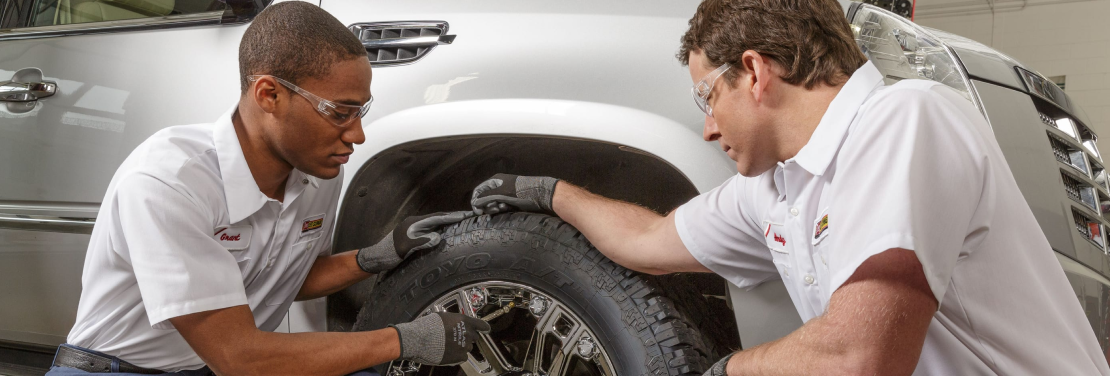Tire Service: The Influence of Weather Conditions
When it comes to making sure ideal efficiency and safety and security when driving, recognizing the impact of climate condition on tire solution is vital. From scorching warmth to icy roadways, each weather component can considerably affect tire functionality and overall driving experience. By diving into the impacts of varying climate problems on tires, vehicle drivers can obtain useful understandings that might boost their automobile's performance and durability. In this discussion, we will certainly explore the detailed relationship in between weather and tire service, clarifying the importance of weather-specific tire upkeep techniques and considerations.
Warm and Tire Performance
When subjected to heats, tires experience modifications in performance that can substantially impact automobile security and handling. The heat generated from prolonged driving or heat conditions creates the tire rubber to soften, resulting in decreased walk life and increased wear. As the rubber comes to be softer, the tire's hold on the roadway reduces, impacting stopping distances and general traction. In severe cases, extreme warm can also cause tire blowouts, positioning a serious security danger to the automobile and its owners.
Additionally, high temperature levels can accelerate the process of tire aging, triggering the rubber to weaken much more quickly. To reduce the effects of heat on tire performance, drivers should regularly inspect their tire stress, turn tires to ensure also use, and examine for any kind of indicators of damages.
Winter Effects
Winter problems can have a considerable effect on tire efficiency and safety and security. As temperature levels decrease, tire rubber can harden, bring about lowered grip on icy or snow-covered roadways. In cold weather, tires might additionally lose air pressure a lot more rapidly, which can affect taking care of and fuel performance. Additionally, chilly temperature levels can cause tire sidewalls to stiffen, raising the risk of damages from fractures or various other road dangers.
To reduce the results of chilly climate on tires, it is essential to regularly examine tire pressure and inflate them to the manufacturer's suggested levels. Using winter or all-season tires developed for cool weather conditions can additionally enhance traction and hold on icy or snowy roads - tires morris il. Correct tire upkeep, consisting of routine examinations for wear and damage, becomes also a lot more crucial throughout cooler months to make sure optimum efficiency and safety
Rainy Issues Impact
During stormy problems, tire efficiency and safety can be significantly affected by the wet roadway surface areas and lowered exposure. The step pattern of tires plays a critical duty in keeping traction on damp roadways. Tires with worn-out treads are extra vulnerable to hydroplaning, where a layer of water develops in between the tire and the roadway surface area, causing loss of traction. To battle this, vehicle drivers must regularly inspect their tires for appropriate walk deepness and consider buying tires specifically developed for damp problems.

Snow and Tire Safety
When driving in snowy conditions, having the right tires can make a significant distinction in safety and efficiency. Wintertime tires are developed with unique rubber substances and walk patterns to provide better traction on snow and ice compared to all-season tires.
In addition to making use of winter months tires, it is important to ensure they are effectively inflated. Cold weather can trigger tire pressure to drop, affecting grip and handling (discount tires morris il). Consistently inspecting and keeping the proper tire pressure is essential for optimum performance in snowy problems

Weather-Related Tire Maintenance
Weather-related tire maintenance includes a range of techniques intended at making sure optimum tire feature and longevity in different weather condition scenarios. One vital facet of weather-related tire upkeep is tire pressure policy. Inspecting tire walk regularly and replacing tires when tread wear reaches a particular depth is crucial for maintaining traction and stability in negative climate.
Conclusion
Finally, climate conditions have a substantial effect on tire performance and security. From warm influencing tire pressure and use to winter lowering grip, it is important to take into consideration the weather when keeping and utilizing tires. Rainy conditions can reduce grasp and cause hydroplaning, while snow can boost the danger a fantastic read of mishaps if tires are not correctly outfitted. Weather-related tire maintenance is vital in making certain ideal performance and safety and security when driving.
In this discussion, we will certainly check out the detailed connection between climate problems and tire service, dropping light on the relevance of weather-specific tire maintenance techniques and considerations.
